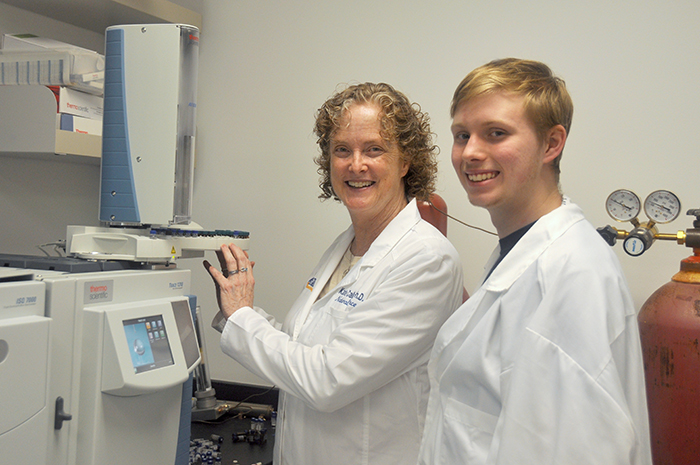- Welcome
- Campus Maps
- History
- Mission Statement
- Accreditation
- Administration
- Employment
- Human Resources Employment Process FAQ
- Position Vacancies
- Salary Schedule (PDF)
- Employee Benefits
- Paid Holidays
- Employee Handbook (PDF)
- BENCOR Special Pay Plan (PDF)
- Social Security Collection and Usage
- Affordable Care Act Notice (PDF)
- Social Security Disclosure Summary (PDF)
- Tobacco-Free College
- Drug Free Workplace & Campuses
- Technology Usage Acknowledgement (PDF)
- Employee Safety Manual (PDF)
- SFSC’s Annual Security and Fire Safety Report (PDF)
- Calendars
- News
- Social Media
- Honoring Our Retirees
- Celebrating Our Trustees

Dr. Kate Calvin (left) and a student from her Organic Chemistry class with the gas chromatograph-mass spectrometer (GC-MS) that is used for research on the Florida Ziziphus.
AVON PARK, Fla. – Nov. 1, 2024 – Through a grant from the Florida Department of Agriculture and Consumer Services, South Florida State College (SFSC) students and faculty, in partnership with Bok Tower in Lake Wales, will continue their studies on the endangered plant, Florida Ziziphus (Pseudoziziphus celata). The agency awarded $12,000 to be available for 13 months as of Oct. 31, 2024. The grant funds originated through the U.S. Fish and Wildlife Service (USFWS).
Florida Ziziphus is one of the rarest and most endangered plants in Florida. This woody shrub is endemic to Florida’s Highlands and Polk counties within a 35-mile stretch of the Lake Wales Ridge. Since its rediscovery in 1987, 16 wild populations with 45 known unique genotypes of Florida Ziziphus have been discovered. However, the plant faces threats due to degraded habitat and the inability to produce seedlings. Its populations are small and genetically limited, with only a fraction secured on protected lands. Wild populations continue to decline. Two populations have had no plants since 2017 and are considered lost. Conservation efforts are needed for habitat restoration, propagation, and the introduction of genetically diverse clones to ensure long-term survival.
The grant monies from the Florida Department of Agriculture and Consumer Services will be used to focus on habitat restoration, genetic diversity enhancement, research, and public education. SFSC’s undergraduate students began research on the Florida Ziziphus under the mentorship of Chemistry Professor Dr. Kate Calvin, in conjunction with Bok Tower, three years ago and will use the grant money to do further research.
Dr. Calvin explained the importance of protecting an endangered species, such as Florida Ziziphus. “Florida Ziziphus is a vital part of the scrub,” she said. “One of its most important roles is to die back and invite fire. The scrub is one of those habitats that relies on fire for self-renewal.”
Further, the gopher tortoise plays a key role within the scrub and the sandhill habitats and has a symbiotic relationship with the Florida Ziziphus. The gopher tortoise has a meal of fruit and the Florida Ziziphus can propagate.
“The gopher tortoise eats the fruit from the Florida Ziziphus, the fruit passes through its gut, and it is released,” Dr. Calvin said. “The acid process and grinding in the tortoise’s stomach helps the Florida Ziziphus seeds germinate. Also, when fire comes, the gopher tortoise’s burrows serve as safe havens for all the creatures in that habitat. All the animals survive. They rely on the tortoise’s burrows.”
The Florida Department of Agriculture and Consumer Services supports and promotes Florida agriculture, protects the environment, safeguards consumers, and ensures the safety and quality of food.
For information about undergraduate research at SFSC, contact Dr. James Hawker, dean of arts and sciences, at james.hawker@southflorida.edu or call 863-784-7329 or contact Dr. Kate Calvin at Kate.Calvin@southflorida.edu.




